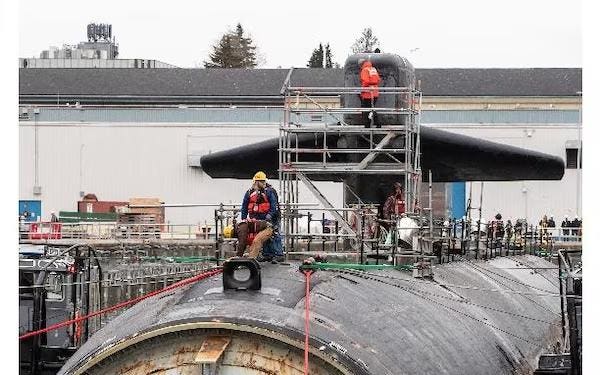In the rush to add naval capacity to the Pacific, the U.S. Navy has almost completely overlooked the Bay Area. Central California’s Cold War-era naval support facilities are long gone, but the Bay Area’s gritty and often-overlooked riverine waterfront offers interesting potential for a Navy desperate to bulk up in-theatre options for nuclear submarine maintenance.
Every Navy admiral and Washington stakeholder agrees the Navy’s overworked submarine fleet needs a new naval shipyard and more maintenance support. But Navy stakeholders, suffering from analysis paralysis and experiential bias, aren’t looking too hard for sites outside of the Navy’s existing network of superbases.
Dubious shipyard advocates are busy peppering the Navy with unwanted, unanalyzed and, ultimately unworkable shipyard ideas, while potentially viable and strategically useful shipyard sites in California’s San Joaquin/Sacramento River delta are almost entirely off the Navy’s radar.
With China looming, it is time to give central California another look.
Everybody Wins With A New California Shipyard:
A new sub maintenance facility in central California is a win for both California and the Navy.
It can happen. While the military, in general, gripes that California doesn’t want manufacturing, a new Bay Area-based naval shipyard, focused on maintaining and repairing America’s high-tech nuclear submarines, gives the Navy the in-theatre maintenance support it needs, while also aligning with California’s wider efforts to promote a high tech, clean-energy future.
A new Bay Area nuclear submarine maintenance facility positions California for innovations ahead. In particular, the commercial maritime, responding to California’s trend-setting demands for ever-lower vessel emissions, is inching towards adopting zero-emission nuclear power options. As host to three of America’s ten largest cargo ports, California had best start preparing for this enormous shift in maritime propulsion.
When the adoption of nuclear in the maritime really gets going, any state with a nuclear-ready workforce will be at a distinct advantage. With some 8,000 nuclear-ready engineers and advanced manufacturing workers employed at the nearby Lawrence Livermore National Laboratory, just an hour away from the San Joaquin/Sacramento River delta, the potential for growth, interagency collaboration and public-private technical innovation will increase.
A new shipyard makes strategic sense. The Navy knows the Bay Area’s strategic utility, and California’s central delta has a storied naval legacy. Mare Island Naval Shipyard, America’s first West Coast naval base, was founded in Vallejo, where Northern California’s waters enter San Francisco Bay. Virtually every commercial port in the delta got their start as a naval depot, fuel pier, or military logistical center.
Take Another Look At The Delta:
The Bay Area’s major river systems, stretching about seventy nautical miles inland, are an underrated strategic asset. Today, the riverine route to the deep-water ports of Stockton and West Sacramento offers some of the few remaining places on the West Coast where heavy industry has low-cost access to the sea.
With a deep 35-foot channel leading to communities that offer far lower waterfront real-estate costs, a more reasonable cost-of-living and a more ready workforce than many conventional West Coast shipyard sites, the region may well offer the U.S. Navy a viable spot for submarine refits, reconstituting some of the resources lost when the Navy closed the Mare Island shipyard.
If the waterfront potential of Sacramento or Stockton fail to suit, then, closer to the Pacific, the gritty Antioch and Pittsburg waterfronts await, replete with aging heavy industrial facilities and semi-abandoned brownfields. Unlike San Francisco and Oakland, these communities have yet to gentrify to the point where they are completely out of the Navy’s reach.
In the California town of Pittsburg, an aging steel manufacturing plant is slated to close at the end of the year. Sporting a deep-draft wharf and great intermodal access, the old facility might be a good candidate to transform into a submarine service or some sort of undersea platform manufacturing site. But the Navy had better move fast—if the facility hasn’t already sold, it’ll soon become just another waterfront warehouse, gobbled up by a murky development firm or, worse, some trading company linked to the Chinese government.
Open spots with potential are disappearing. In Antioch, a slice of long-vacant waterfront is now host to Amports, a vehicle storage and transport company. Nearby, the old Fulton Shipyard, a site that once produced Navy minesweepers and tugs, is slowly being gobbled up for municipal water intakes and recreational use. Land Stockton’s eight World War II-era shipbuilders used to build everything from floating dry docks to berthing barges has long-vanished, appropriated for housing, ballparks and marinas.
The Federal Government still has some waterfront access in the Bay Area. While likely ill-suited for shipyard facilities, the U.S. Army’s Military Ocean Terminal Concord (MOTCO), or the Department of Transportation’s ever-shrinking Suisun Bay Reserve Fleet outpost in Benicia offer shoreside footprints that could, in a pinch, be evaluated for potential utility as a shipyard.
If the Navy is unable to move quickly, all is not lost. In time, one or more of the Bay Area’s five fuel refineries will close. Unlikely to be easily repurposed, one of the facilities might offer an interesting opportunity for the Navy to expand. But, given the pressing need, coupled with the Bay Area’s strategic utility, it is time for the U.S. Navy to start moving forward. Scouting out the Bay Area for a new shipyard is a good first step.
Read the full article here





